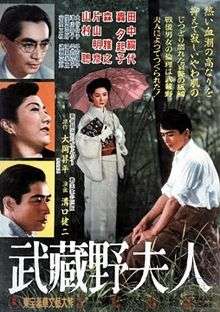The Lady of Musashino
The Lady of Musashino (武蔵野夫人, Musashino-Fujin) is a 1951 Japanese film directed by Kenji Mizoguchi. The script for the film was adapted by Mizoguchi from the best-selling serial novel by Shōhei Ōoka.[1]
| The Lady of Musashino | |
|---|---|
 Original Japanese movie poster | |
| Directed by | Kenji Mizoguchi |
| Produced by | Hideo Koi |
| Written by | Yoshikata Yoda |
| Starring | Kinuyo Tanaka |
| Music by | Fumio Hayasaka |
| Cinematography | Masao Tamai |
| Edited by | Ryoji Sakato |
| Distributed by | Toho |
Release date | 14 September 1951 |
Running time | 88 min. |
| Country | Japan |
| Language | Japanese |
Plot
Michiko Akiyama (Kinuyo Tanaka) is married to Tadao Akiyama (Masayuki Mori), a college professor but a vulgar man with a low-class background. Towards the end of World War II, they flee the Bombing of Tokyo to her parents' estate in the suburban Musashino. When her parents die, Michiko inherits the estate. Nearby is her cousin, Eiji Ono (So Yamamura), a wartime profiteer with loose morals, and his wife Tomiko (Yukiko Todoroki). After the end of the war, the extended family is joined by the young and handsome Tsutomu Miyaji (Akihito Katayama), another cousin of hers and former prisoner-of-war.
In the immediate post-war era, Japanese traditions and morals decline. Tadao comes home drunk every night and has sexual relationships with students.
He also propositions Tomiko. However, Tomiko, unhappy in her marriage, also lusts after Tsutomu.
Michiko also has mutual feelings for Tsutomu but resists his advances because she is a married woman and because she does not want him to fall prey to permissiveness. However, when she learns of her husband's plans to swindle her out of her inheritance and run off with Tomiko, she decides to commit suicide to frustrate Tadao's theft and to leave most of her estate to Tsutomu.
Cast
- Kinuyo Tanaka as Michiko Akiyama
- Yukiko Todoroki as Tomiko Ono
- Masayuki Mori as Tadao Akiyama
- Akihito Katayama as Tsutomu Miyaji
- So Yamamura as Eiji Ono
- Eitarō Shindō as Shinzaburo Miyaji
- Kiyoko Hirai as Tamiko Miyaji
- Minako Nakamura as Yukiko Ono
- Noriko Sengoku as Maid in the Ono house
Themes
The main theme of The Lady of Musashino is the moral decline of Japan’s traditional culture and morality in a society disrupted by the aftermath of World War II, and the sudden influx of foreign ideas and foreign moral concepts.
Production
Eiji Tsubaraya designed the visual effects for the film.[2]
Release
A PAL edition DVD of the film was released by Artificial Eye in 2004.[3]
References
- Richie, Donald (2005). A hundred years of Japanese film: a concise history, with a selective guide to DVDs and videos. Kodansha International. p. 277. ISBN 978-4-7700-2995-9.
- Ragone, August (2007). Eiji Tsuburaya: master of monsters : defending the earth with Ultraman, Godzilla, and friends in the golden age of Japanese science fiction film. Chronicle Books. p. 195. ISBN 978-0-8118-6078-9.
- Musashino fujin = The lady of Musashino (DVD video, 2004). WorldCat.org. OCLC 85222337.